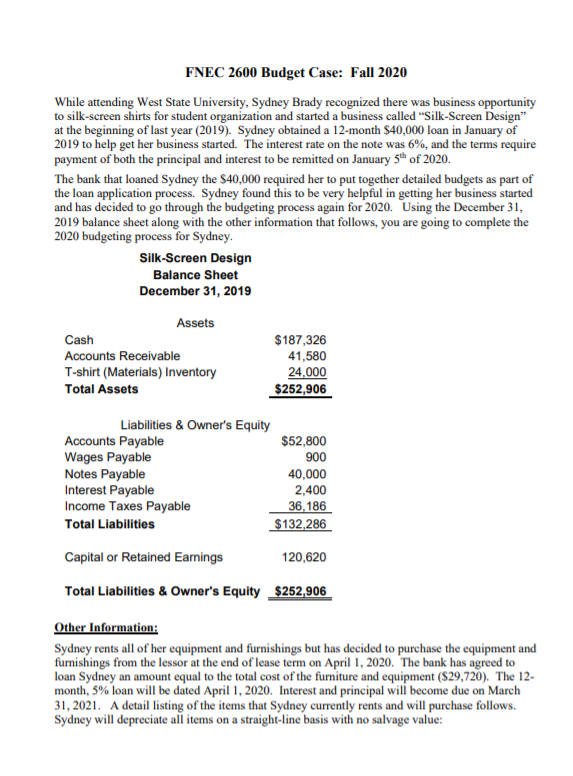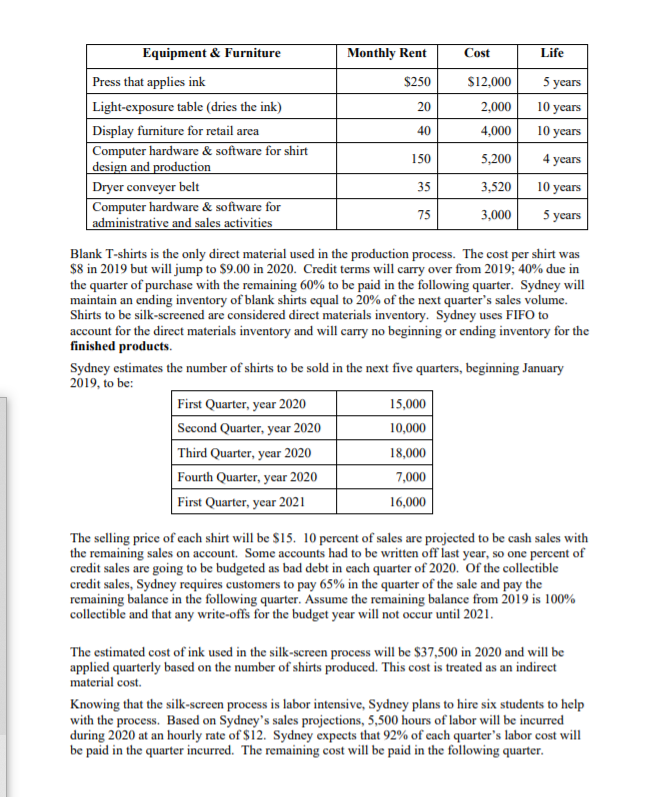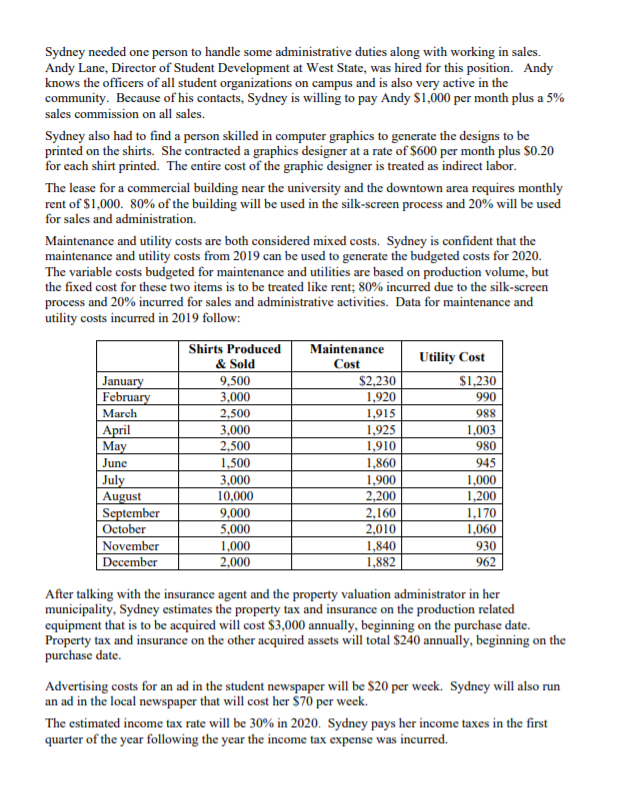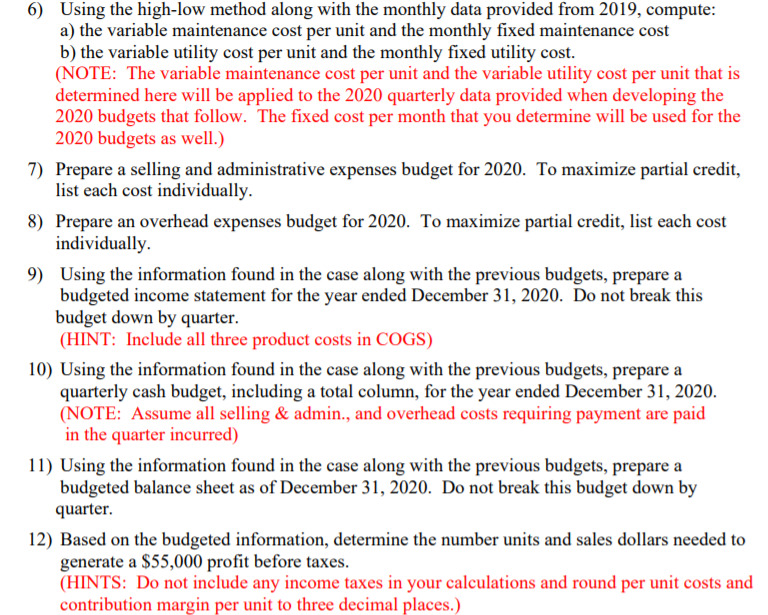




FNEC 2600 Budget Case: Fall 2020 While attending West State University, Sydney Brady recognized there was business opportunity to silk-screen shirts for student organization and started a business called "Silk-Screen Design at the beginning of last year (2019). Sydney obtained a 12-month $40,000 loan in January of 2019 to help get her business started. The interest rate on the note was 6%, and the terms require payment of both the principal and interest to be remitted on January 5 of 2020. The bank that loaned Sydney the $40,000 required her to put together detailed budgets as part of the loan application process. Sydney found this to be very helpful in getting her business started and has decided to go through the budgeting process again for 2020. Using the December 31, 2019 balance sheet along with the other information that follows, you are going to complete the 2020 budgeting process for Sydney. Silk-Screen Design Balance Sheet December 31, 2019 Assets Cash Accounts Receivable T-shirt (Materials) Inventory Total Assets $187,326 41,580 24,000 $252,906 Liabilities & Owner's Equity Accounts Payable $52,800 Wages Payable 900 Notes Payable 40,000 Interest Payable 2,400 Income Taxes Payable 36,186 Total Liabilities $132,286 Capital or Retained Earnings 120,620 Total Liabilities & Owner's Equity $252,906 Other Information: Sydney rents all of her equipment and furnishings but has decided to purchase the equipment and furnishings from the lessor at the end of lease term on April 1, 2020. The bank has agreed to loan Sydney an amount equal to the total cost of the furniture and equipment ($29,720). The 12- month, 3% loan will be dated April 1, 2020. Interest and principal will become due on March 31, 2021. A detail listing of the items that Sydney currently rents and will purchase follows. Sydney will depreciate all items on a straight-line basis with no salvage value: 150 75 5 years Equipment & Furniture Monthly Rent Cost Life Press that applies ink $250 $12,000 5 years Light-exposure table (dries the ink) 20 2,000 10 years Display furniture for retail area 40 4,000 10 years Computer hardware & software for shirt 5,200 4 years design and production Dryer conveyer belt 35 3,520 10 years Computer hardware & software for 3,000 administrative and sales activities Blank T-shirts is the only direct material used in the production process. The cost per shirt was $8 in 2019 but will jump to $9.00 in 2020. Credit terms will carry over from 2019, 40% due in the quarter of purchase with the remaining 60% to be paid in the following quarter. Sydney will maintain an ending inventory of blank shirts equal to 20% of the next quarter's sales volume. Shirts to be silk-screened are considered direct materials inventory. Sydney uses FIFO to account for the direct materials inventory and will carry no beginning or ending inventory for the finished products. Sydney estimates the number of shirts to be sold in the next five quarters, beginning January 2019, to be: First Quarter, year 2020 15,000 Second Quarter, year 2020 10,000 Third Quarter, year 2020 18,000 Fourth Quarter, year 2020 7,000 First Quarter, year 2021 16,000 The selling price of each shirt will be $15. 10 percent of sales are projected to be cash sales with the remaining sales on account. Some accounts had to be written off last year, so one percent of credit sales are going to be budgeted as bad debt in each quarter of 2020. Of the collectible credit sales, Sydney requires customers to pay 65% in the quarter of the sale and pay the remaining balance in the following quarter. Assume the remaining balance from 2019 is 100% collectible and that any write-offs for the budget year will not occur until 2021. The estimated cost of ink used in the silk-screen process will be $37,500 in 2020 and will be applied quarterly based on the number of shirts produced. This cost is treated as an indirect material cost Knowing that the silk-screen process is labor intensive, Sydney plans to hire six students to help with the process. Based on Sydney's sales projections, 5,500 hours of labor will be incurred during 2020 at an hourly rate of $12. Sydney expects that 92% of each quarter's labor cost will be paid in the quarter incurred. The remaining cost will be paid in the following quarter. Sydney needed one person to handle some administrative duties along with working in sales. Andy Lane, Director of Student Development at West State, was hired for this position. Andy knows the officers of all student organizations on campus and is also very active in the community. Because of his contacts, Sydney is willing to pay Andy $1,000 per month plus a 5% sales commission on all sales. Sydney also had to find a person skilled in computer graphics to generate the designs to be printed on the shirts. She contracted a graphics designer at a rate of $600 per month plus $0.20 for each shirt printed. The entire cost of the graphic designer is treated as indirect labor. The lease for a commercial building near the university and the downtown area requires monthly rent of $1,000. 80% of the building will be used in the silk-screen process and 20% will be used for sales and administration. Maintenance and utility costs are both considered mixed costs. Sydney is confident that the maintenance and utility costs from 2019 can be used to generate the budgeted costs for 2020. The variable costs budgeted for maintenance and utilities are based on production volume, but the fixed cost for these two items is to be treated like rent; 80% incurred due to the silk-screen process and 20% incurred for sales and administrative activities. Data for maintenance and utility costs incurred in 2019 follow: January February March April May June July August September October November December Shirts Produced & Sold 9,500 3,000 2,500 3,000 2,500 1,500 3,000 10,000 9,000 5,000 1,000 2.000 Maintenance Cost $2,230 1,920 1,915 1,925 1,910 1,860 1,900 2,200 2,160 2,010 1,840 1,882 Utility Cost $1,230 990 988 1,003 980 945 1,000 1,200 1.170 1,060 930 962 After talking with the insurance agent and the property valuation administrator in her municipality, Sydney estimates the property tax and insurance on the production related equipment that is to be acquired will cost $3,000 annually, beginning on the purchase date. Property tax and insurance on the other acquired assets will total $250 annually, beginning on the purchase date. Advertising costs for an ad in the student newspaper will be $20 per week. Sydney will also run an ad in the local newspaper that will cost her $70 per week. The estimated income tax rate will be 30% in 2020. Sydney pays her income taxes in the first quarter of the year following the year the income tax expense was incurred. Instructions: For instructions 1-8 and instruction #10, set up a column for each quarter of the year and also a total column for the year. Round all amounts to the nearest dollar on instructions 1-11. 6) Using the high-low method along with the monthly data provided from 2019, compute: a) the variable maintenance cost per unit and the monthly fixed maintenance cost b) the variable utility cost per unit and the monthly fixed utility cost. (NOTE: The variable maintenance cost per unit and the variable utility cost per unit that is determined here will be applied to the 2020 quarterly data provided when developing the 2020 budgets that follow. The fixed cost per month that you determine will be used for the 2020 budgets as well.) 7) Prepare a selling and administrative expenses budget for 2020. To maximize partial credit, list each cost individually. 8) Prepare an overhead expenses budget for 2020. To maximize partial credit, list each cost individually. 9) Using the information found in the case along with the previous budgets, prepare a budgeted income statement for the year ended December 31, 2020. Do not break this budget down by quarter. (HINT: Include all three product costs in COGS) 10) Using the information found in the case along with the previous budgets, prepare a quarterly cash budget, including a total column, for the year ended December 31, 2020. (NOTE: Assume all selling & admin., and overhead costs requiring payment are paid in the quarter incurred) 11) Using the information found in the case along with the previous budgets, prepare a budgeted balance sheet as of December 31, 2020. Do not break this budget down by quarter. 12) Based on the budgeted information, determine the number units and sales dollars needed to generate a $55,000 profit before taxes. (HINTS: Do not include any income taxes in your calculations and round per unit costs and contribution margin per unit to three decimal places.) FNEC 2600 Budget Case: Fall 2020 While attending West State University, Sydney Brady recognized there was business opportunity to silk-screen shirts for student organization and started a business called "Silk-Screen Design at the beginning of last year (2019). Sydney obtained a 12-month $40,000 loan in January of 2019 to help get her business started. The interest rate on the note was 6%, and the terms require payment of both the principal and interest to be remitted on January 5 of 2020. The bank that loaned Sydney the $40,000 required her to put together detailed budgets as part of the loan application process. Sydney found this to be very helpful in getting her business started and has decided to go through the budgeting process again for 2020. Using the December 31, 2019 balance sheet along with the other information that follows, you are going to complete the 2020 budgeting process for Sydney. Silk-Screen Design Balance Sheet December 31, 2019 Assets Cash Accounts Receivable T-shirt (Materials) Inventory Total Assets $187,326 41,580 24,000 $252,906 Liabilities & Owner's Equity Accounts Payable $52,800 Wages Payable 900 Notes Payable 40,000 Interest Payable 2,400 Income Taxes Payable 36,186 Total Liabilities $132,286 Capital or Retained Earnings 120,620 Total Liabilities & Owner's Equity $252,906 Other Information: Sydney rents all of her equipment and furnishings but has decided to purchase the equipment and furnishings from the lessor at the end of lease term on April 1, 2020. The bank has agreed to loan Sydney an amount equal to the total cost of the furniture and equipment ($29,720). The 12- month, 3% loan will be dated April 1, 2020. Interest and principal will become due on March 31, 2021. A detail listing of the items that Sydney currently rents and will purchase follows. Sydney will depreciate all items on a straight-line basis with no salvage value: 150 75 5 years Equipment & Furniture Monthly Rent Cost Life Press that applies ink $250 $12,000 5 years Light-exposure table (dries the ink) 20 2,000 10 years Display furniture for retail area 40 4,000 10 years Computer hardware & software for shirt 5,200 4 years design and production Dryer conveyer belt 35 3,520 10 years Computer hardware & software for 3,000 administrative and sales activities Blank T-shirts is the only direct material used in the production process. The cost per shirt was $8 in 2019 but will jump to $9.00 in 2020. Credit terms will carry over from 2019, 40% due in the quarter of purchase with the remaining 60% to be paid in the following quarter. Sydney will maintain an ending inventory of blank shirts equal to 20% of the next quarter's sales volume. Shirts to be silk-screened are considered direct materials inventory. Sydney uses FIFO to account for the direct materials inventory and will carry no beginning or ending inventory for the finished products. Sydney estimates the number of shirts to be sold in the next five quarters, beginning January 2019, to be: First Quarter, year 2020 15,000 Second Quarter, year 2020 10,000 Third Quarter, year 2020 18,000 Fourth Quarter, year 2020 7,000 First Quarter, year 2021 16,000 The selling price of each shirt will be $15. 10 percent of sales are projected to be cash sales with the remaining sales on account. Some accounts had to be written off last year, so one percent of credit sales are going to be budgeted as bad debt in each quarter of 2020. Of the collectible credit sales, Sydney requires customers to pay 65% in the quarter of the sale and pay the remaining balance in the following quarter. Assume the remaining balance from 2019 is 100% collectible and that any write-offs for the budget year will not occur until 2021. The estimated cost of ink used in the silk-screen process will be $37,500 in 2020 and will be applied quarterly based on the number of shirts produced. This cost is treated as an indirect material cost Knowing that the silk-screen process is labor intensive, Sydney plans to hire six students to help with the process. Based on Sydney's sales projections, 5,500 hours of labor will be incurred during 2020 at an hourly rate of $12. Sydney expects that 92% of each quarter's labor cost will be paid in the quarter incurred. The remaining cost will be paid in the following quarter. Sydney needed one person to handle some administrative duties along with working in sales. Andy Lane, Director of Student Development at West State, was hired for this position. Andy knows the officers of all student organizations on campus and is also very active in the community. Because of his contacts, Sydney is willing to pay Andy $1,000 per month plus a 5% sales commission on all sales. Sydney also had to find a person skilled in computer graphics to generate the designs to be printed on the shirts. She contracted a graphics designer at a rate of $600 per month plus $0.20 for each shirt printed. The entire cost of the graphic designer is treated as indirect labor. The lease for a commercial building near the university and the downtown area requires monthly rent of $1,000. 80% of the building will be used in the silk-screen process and 20% will be used for sales and administration. Maintenance and utility costs are both considered mixed costs. Sydney is confident that the maintenance and utility costs from 2019 can be used to generate the budgeted costs for 2020. The variable costs budgeted for maintenance and utilities are based on production volume, but the fixed cost for these two items is to be treated like rent; 80% incurred due to the silk-screen process and 20% incurred for sales and administrative activities. Data for maintenance and utility costs incurred in 2019 follow: January February March April May June July August September October November December Shirts Produced & Sold 9,500 3,000 2,500 3,000 2,500 1,500 3,000 10,000 9,000 5,000 1,000 2.000 Maintenance Cost $2,230 1,920 1,915 1,925 1,910 1,860 1,900 2,200 2,160 2,010 1,840 1,882 Utility Cost $1,230 990 988 1,003 980 945 1,000 1,200 1.170 1,060 930 962 After talking with the insurance agent and the property valuation administrator in her municipality, Sydney estimates the property tax and insurance on the production related equipment that is to be acquired will cost $3,000 annually, beginning on the purchase date. Property tax and insurance on the other acquired assets will total $250 annually, beginning on the purchase date. Advertising costs for an ad in the student newspaper will be $20 per week. Sydney will also run an ad in the local newspaper that will cost her $70 per week. The estimated income tax rate will be 30% in 2020. Sydney pays her income taxes in the first quarter of the year following the year the income tax expense was incurred. Instructions: For instructions 1-8 and instruction #10, set up a column for each quarter of the year and also a total column for the year. Round all amounts to the nearest dollar on instructions 1-11. 6) Using the high-low method along with the monthly data provided from 2019, compute: a) the variable maintenance cost per unit and the monthly fixed maintenance cost b) the variable utility cost per unit and the monthly fixed utility cost. (NOTE: The variable maintenance cost per unit and the variable utility cost per unit that is determined here will be applied to the 2020 quarterly data provided when developing the 2020 budgets that follow. The fixed cost per month that you determine will be used for the 2020 budgets as well.) 7) Prepare a selling and administrative expenses budget for 2020. To maximize partial credit, list each cost individually. 8) Prepare an overhead expenses budget for 2020. To maximize partial credit, list each cost individually. 9) Using the information found in the case along with the previous budgets, prepare a budgeted income statement for the year ended December 31, 2020. Do not break this budget down by quarter. (HINT: Include all three product costs in COGS) 10) Using the information found in the case along with the previous budgets, prepare a quarterly cash budget, including a total column, for the year ended December 31, 2020. (NOTE: Assume all selling & admin., and overhead costs requiring payment are paid in the quarter incurred) 11) Using the information found in the case along with the previous budgets, prepare a budgeted balance sheet as of December 31, 2020. Do not break this budget down by quarter. 12) Based on the budgeted information, determine the number units and sales dollars needed to generate a $55,000 profit before taxes. (HINTS: Do not include any income taxes in your calculations and round per unit costs and contribution margin per unit to three decimal places.)











